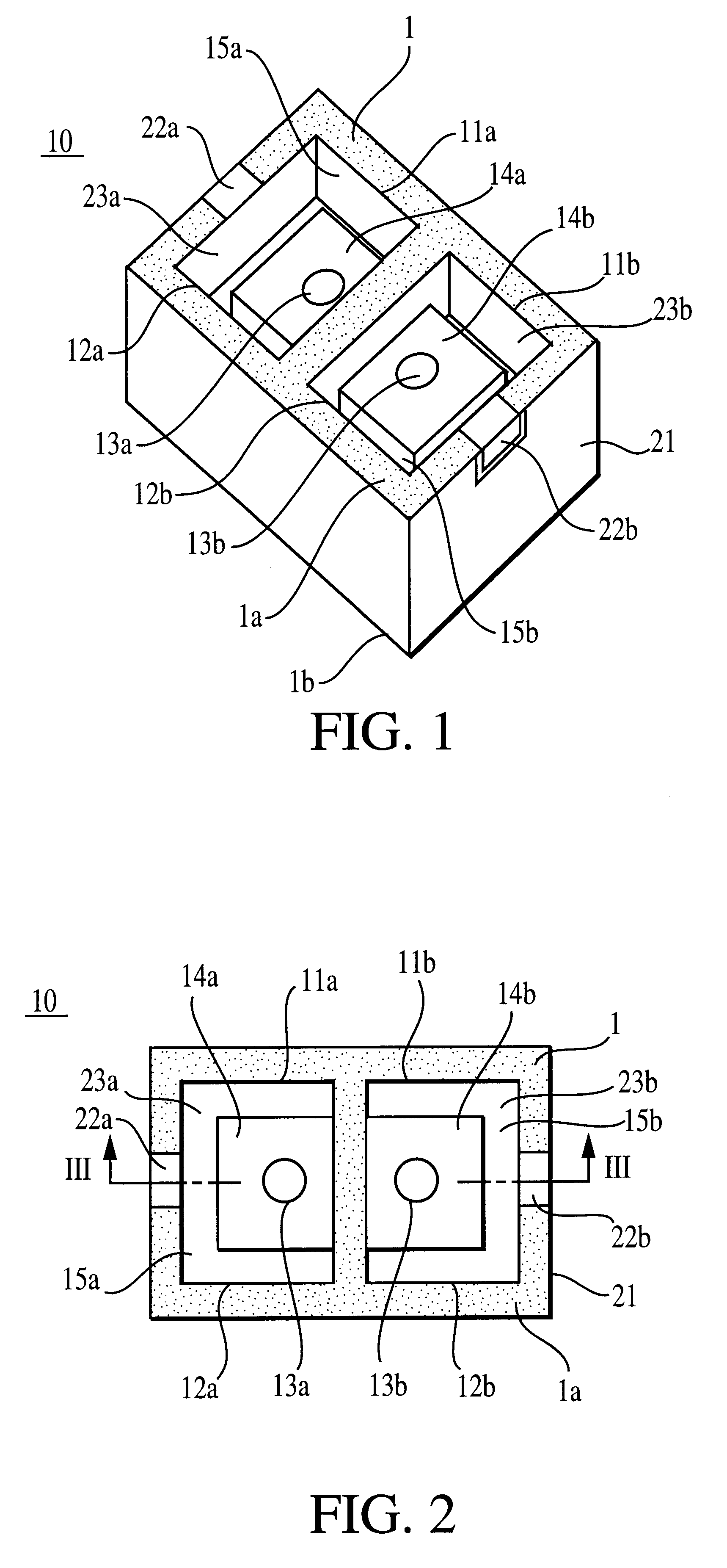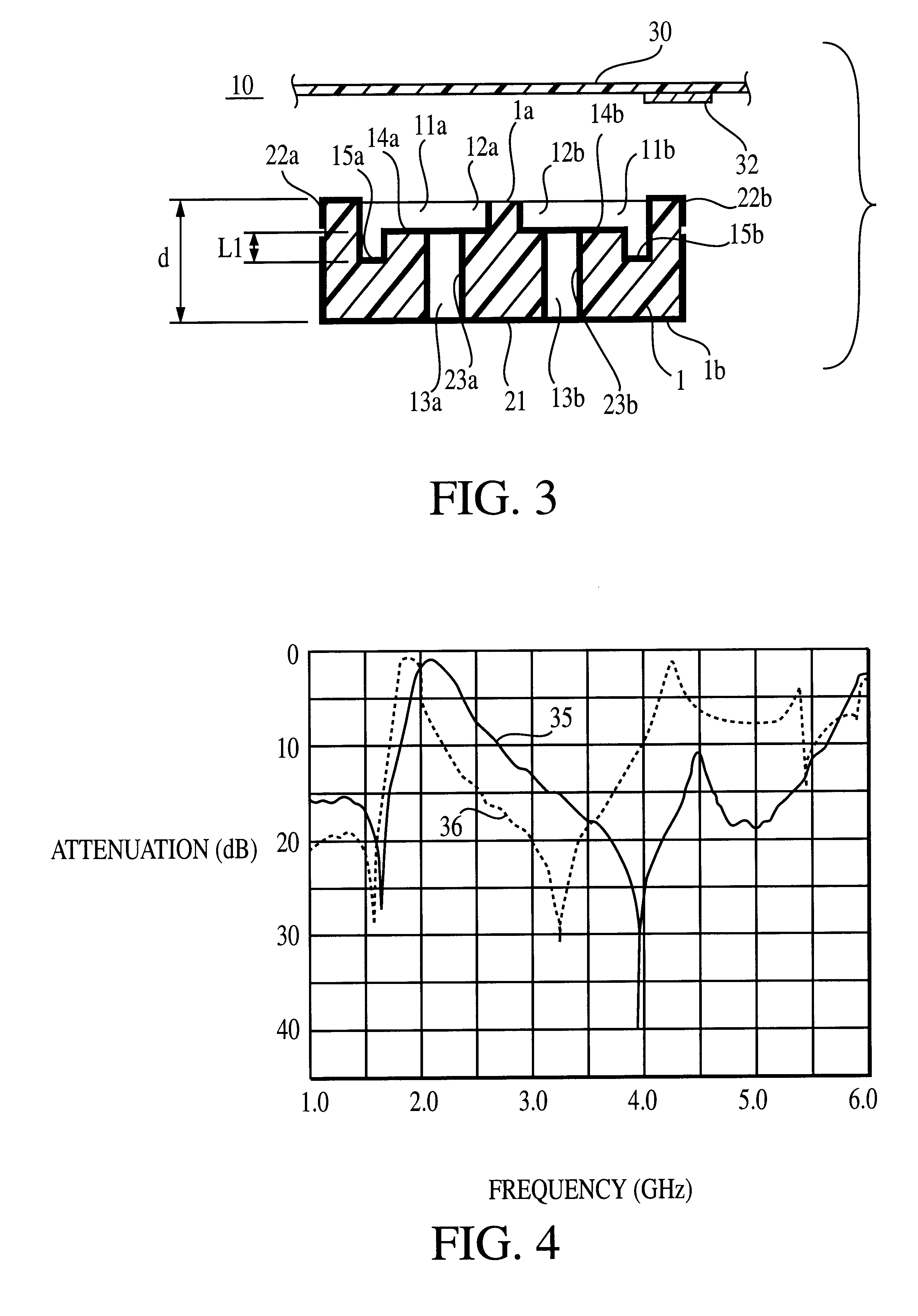Dielectric filter having at least one stepped resonator hole with a recessed or protruding portion, the stepped resonator hole extending from a mounting surface
- Summary
- Abstract
- Description
- Claims
- Application Information
AI Technical Summary
Benefits of technology
Problems solved by technology
Method used
Image
Examples
first embodiment
[First Embodiment, FIG. 1 to FIG. 8]
As shown in FIG. 1 to FIG. 3, a dielectric filter 10 has two resonator holes 11a and 11b passing through opposing surfaces 1a and 1b of a dielectric block 1. The resonator holes 11a and 11b have large and rectangular cross-sectional hole portions 12a and 12b as large-sectional area portions, and small and circular cross-sectional hole portions 13a and 13b as small-sectional area portions mechanically connected to the large-sectional area portions 12a and 12b, respectively. The axes of the large-sectional area portions 12a and 12b shift from those of the small-sectional area portions 13a and 13b. The degree of coupling in the dielectric filter 10 is determined by the distance of the axes of the adjacent large-sectional area portions 12a and 12b, the distance between the axes of the small-sectional area portions 13a and 13b, and other factors.
On step portions 14a and 14b at the boundaries of the large-sectional area portions 12a and 12b and the smal...
second embodiment
[Second Embodiment, FIG. 8]
As shown in FIG. 8, a dielectric filter 18 according to a second embodiment has the same configuration as the dielectric filter 10 according to the first embodiment, except for an outer conductor 21, inner conductors 23a and 23b, and input and output electrodes 22a and 22b. The outer conductor 21 is formed almost all outer surfaces of a dielectric block 1. The pair of input and output electrodes 22a and 22b are formed on outer surfaces of the dielectric block 1 without electrically connecting to the outer conductor 21 with a gap from the outer conductor 21. The input and output electrodes 22a and 22b are connected to an external circuit through a capacitor or other elements as required.
The inner conductors 23a and 23b are formed on almost all inner surfaces of resonator holes 11a and 11b. Gaps 19 are provided between the inner conductors 23a and 23b and the outer conductor 21 extending to the opening sections of large-sectional area portions 12a and 12b. T...
third embodiment
[Third Embodiment, FIG. 9 and FIG. 10]
As shown in FIG. 9 and FIG. 10, in a dielectric filter 20, protruding portions 16a and 16b are formed on step portions 14a and 14b in resonator holes 11a and 11b with a certain distance from small-sectional area portions 13a and 13b. The protruding portions 16a and 16b are formed such that they surround about three-fourths the small-sectional area portions 13a and 13b with the adjacent inner surfaces of large-sectional area portions 12a and 12b being left.
In the dielectric filter 20 configured as described above, since the protruding portions 16a and 16b are formed on the step portions 14a and 14b, the conductive-path lengths of the inner conductors 23a and 23b become longer than those in a conventional dielectric filter having no protruding portions by twice the length L2 of the side walls of the protruding portions 16a and 16b. Therefore, with the same center frequency, the dielectric filter 20 can have a shorter axial length "d" of the resona...
PUM
 Login to View More
Login to View More Abstract
Description
Claims
Application Information
 Login to View More
Login to View More - R&D
- Intellectual Property
- Life Sciences
- Materials
- Tech Scout
- Unparalleled Data Quality
- Higher Quality Content
- 60% Fewer Hallucinations
Browse by: Latest US Patents, China's latest patents, Technical Efficacy Thesaurus, Application Domain, Technology Topic, Popular Technical Reports.
© 2025 PatSnap. All rights reserved.Legal|Privacy policy|Modern Slavery Act Transparency Statement|Sitemap|About US| Contact US: help@patsnap.com



